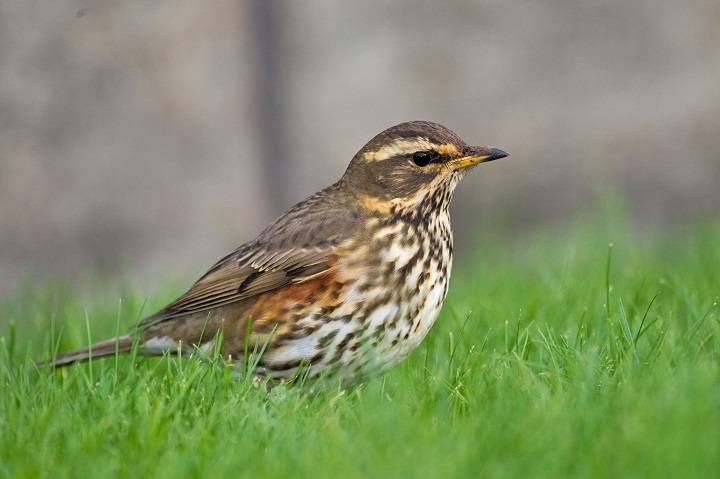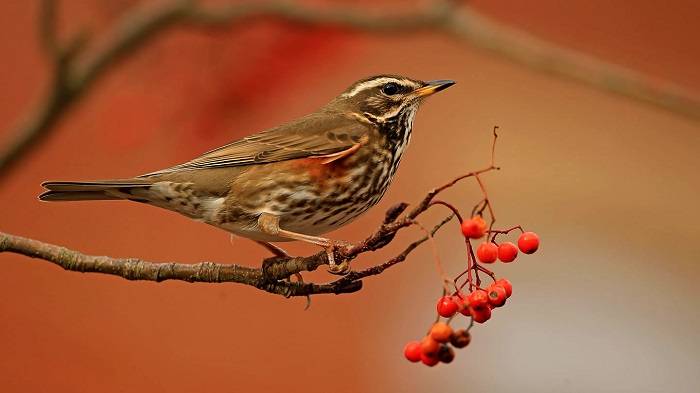The Redwing bird, with its distinctive red flank patches and melodic song, is a beloved winter visitor to the UK. As the crisp autumn air descends and the countryside transforms into a patchwork of vibrant hues, the arrival of these charming thrushes marks the beginning of the festive season. In this comprehensive guide, we’ll delve into the fascinating world of the Redwing bird, exploring its habitat, behavior, migration patterns, and conservation status in the UK.
The Redwing Bird
The Redwing (Turdus iliacus) is a small member of the thrush family, characterized by its rich chestnut flanks, creamy striping on the face, and bold white supercilium. These migratory birds breed in the northern regions of Scandinavia and Russia during the summer months before embarking on their annual winter migration to the UK and other parts of Europe.
Habitat and Distribution
Redwings are predominantly found in wooded areas, hedgerows, parks, and gardens across the UK during the winter months. They are particularly fond of open countryside with abundant fruit-bearing trees and shrubs, where they can forage for berries and insects to sustain themselves during the colder months.
Identification
Identifying Redwings can be relatively straightforward, especially during the winter months when they are most commonly sighted in the UK. Look out for the following key features:
- Chestnut flanks with bold black streaks.
- Creamy-white stripe above the eye (supercilium).
- Pale throat and belly with dark speckling.
- Slim, pointed bill adapted for feeding on berries and insects.
- Melodic song consisting of a series of high-pitched whistles and trills.
Behavior and Feeding Habits
Redwings are primarily insectivorous during the breeding season, feeding on a variety of invertebrates such as worms, beetles, and caterpillars. However, during the winter months in the UK, their diet shifts to include a significant proportion of berries and other fruit-bearing plants. They are particularly fond of rowan berries, hawthorn berries, and rosehips, which provide essential nutrients to sustain them through the colder months.
Migration Patterns
One of the most remarkable aspects of the Redwing’s behavior is its annual migration from its breeding grounds in Scandinavia and Russia to its wintering grounds in the UK and other parts of Europe. These migratory journeys can cover thousands of kilometers and are driven by a combination of factors including food availability, daylight hours, and weather conditions.
Redwings typically begin arriving in the UK in late September to early October, with peak numbers occurring in November and December. They often travel in large flocks, creating a spectacle as they descend upon hedgerows and berry-laden trees in search of food.
Conservation Status
In the UK, Redwings are considered a common winter visitor and are not currently listed as a species of conservation concern. However, like many other migratory birds, they face threats such as habitat loss, climate change, and predation. Conservation efforts focused on maintaining and enhancing suitable habitat, particularly in agricultural landscapes, are crucial for ensuring the long-term survival of Redwing populations.
How to Attract Redwings to Your Garden
If you’re keen to attract Redwings to your garden, there are several steps you can take to create an inviting habitat:
- Plant Berry-Bearing Trees and Shrubs: Redwings are particularly drawn to gardens with an abundance of fruit-bearing trees and shrubs. Consider planting species such as rowan (mountain ash), hawthorn, cotoneaster, and holly to provide a natural food source.
- Provide Fresh Water: Redwings, like all birds, require access to fresh water for drinking and bathing. A shallow bird bath or wildlife pond can be a valuable addition to your garden, especially during dry periods.
- Avoid Using Pesticides: Pesticides can harm the insects that Redwings rely on for food, so try to minimize their use in your garden. Opt for natural pest control methods such as companion planting and encouraging natural predators like birds and beneficial insects.
- Create Shelter: Redwings appreciate sheltered spots where they can rest and roost safely. Dense shrubs, hedgerows, and evergreen trees provide ideal cover, especially during inclement weather.
- Offer Supplementary Food: While Redwings primarily feed on natural food sources, they may also be attracted to supplementary foods such as mealworms, suet pellets, and fruit scraps. Ensure that any food offerings are placed in suitable feeders and kept clean to prevent the spread of disease.
Redwing Bird UK
Related Post:
Species of Bird Male Colorful Tail: Details Biography
Indiana Bird Species: Know the Unknown Facts
Orange Bird Species: Behave, Diet and Lifestyle
The Redwing bird holds a special place in the hearts of many birdwatchers and nature enthusiasts in the UK. Its arrival heralds the changing seasons and brings a touch of wild beauty to gardens, parks, and countryside landscapes across the country. By understanding the Redwing’s habitat requirements, behavior, and conservation needs, we can all play a role in ensuring that these delightful winter visitors continue to grace our shores for generations to come.




